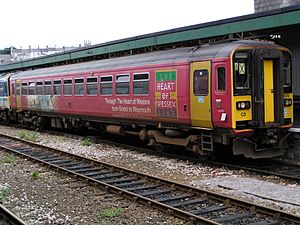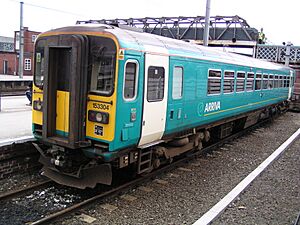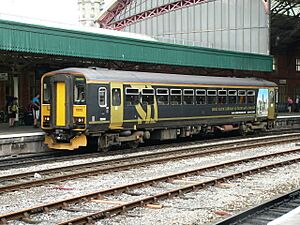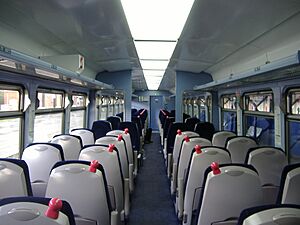British Rail Class 153 facts for kids
Quick facts for kids British Rail Class 153 "Sprinter" |
|
|---|---|

Class 153, no. 153335 'Michael Palin' at Cambridge on 11th July 2003.
|
|
| In service | 1991/2 - present |
| Manufacturer | Leyland Motors |
| Family name | Sprinter |
| Refurbishment | Converted by by Leyland Bus |
| Number built | 70 (35 as Class 155s) |
| Formation | 1 car |
| Capacity | 75 |
| Operator(s) | Arriva Trains Wales East Midlands Trains First Great Western London Midland National Express East Anglia Northern Rail |
| Line(s) served | Many including Bletchley-Bedford, Nuneaton-Coventry, Birmingham-Walsall-Rugeley Trent Valley (in multiple with Class 170), Nottingham-Matlock, Heart of Wales Line, Truro-Falmouth |
| Specifications | |
| Car length | 23.2 metres |
| Width | 2.7 metres |
| Maximum speed | 75mph |
| Weight | 41.2 tonnes |
| Prime mover(s) | Cummins NT855R5 of 213kW (285h.p.) at 2100 rpm |
| Safety system(s) | AWS, TPWS |
| Coupling system | BSI Compact |
| Track gauge | 1435 mm (4 ft 8½ in) |
The British Rail Class 153 "Sprinter" is a special kind of train. It is a single-car diesel multiple unit. This means it's a train that runs on diesel fuel and has its own engine. It doesn't need a separate locomotive to pull it along. These trains are often used on quieter, local railway lines across the UK.


Contents
About the Class 153 Sprinter
The Class 153 Sprinter is a unique train because it has only one carriage. In the early 1990s, the railway company British Rail decided that using two-carriage trains on less busy routes wasn't the best idea. They needed smaller, single-carriage trains to save money and be more efficient.
How They Were Made
Instead of building brand new single-car trains, British Rail decided to change some existing ones. They took 35 two-car trains from the Class 155 series. Each of these Class 155 trains was split into two separate single-car units. This created 70 new Class 153 trains. These trains were rebuilt by Leyland Bus to become the single-car units we see today.
Where Do They Run?
Class 153 trains are very versatile. They can be found on many different railway lines across the country. They are especially useful for routes where there aren't many passengers, or for adding extra space to longer trains during busy times.
Some of the lines they serve include:
- The Bletchley to Bedford line
- The Nuneaton to Coventry line
- The Heart of Wales Line
- Routes between Nottingham and Matlock
- Services from Truro to Falmouth
They often work with other trains, like the Class 170, to carry more people.
Train Features
Each Class 153 train is about 23.2 metres long and weighs 41.2 tonnes. They can carry around 75 passengers and have a top speed of 75 miles per hour. They are powered by a Cummins diesel engine. These trains have important safety systems like AWS and TPWS to help prevent accidents.
Images for kids
-
Arriva Trains Wales 153323 at Cardiff Central in August 2014
-
Regional Railways 153374 at Severn Beach in March 1994
-
Wessex Trains 153377 at Bristol Temple Meads in January 2006
-
First Great Western 153373 at Starcross in November 2013
-
East Midlands Trains 153357 at Alsager in June 2015
-
Northern Rail 153352 at Lancaster in May 2015













